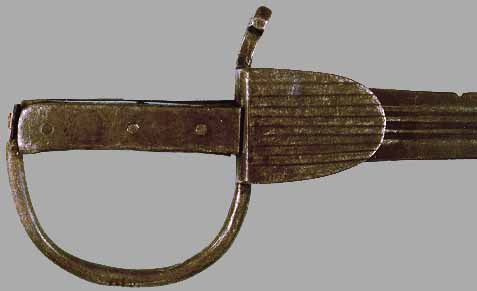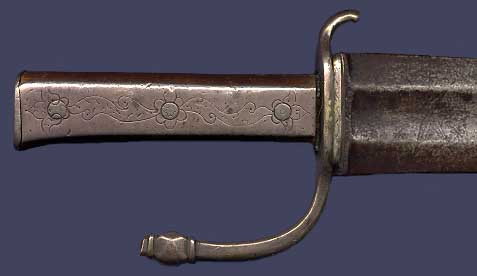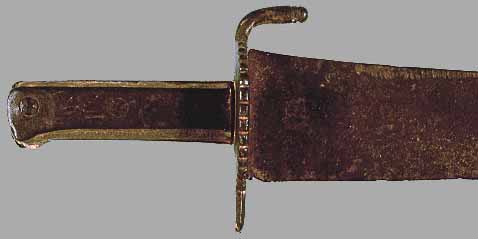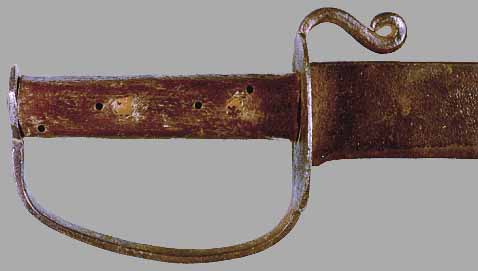 |
 |
|
|
 |
 |
|
|
The espada ancha or "wide sword" is a form characteristic of and unique to the northern frontiers of New Spain; that is, what is now northern Mexico and the southwestern United States. Brinckerhoff and Chamberlain (1972, p. 74 - 75) postulate that these swords evolved in the early 18th Century from 17th Century Spanish style civilian or hunting broadswords whose 76 to 92 cm. (30 to 36 inch) long blades came to be cut down to lengths between 45 and 66 cm. (18 and 26 inches). From their inception, espada anchas were used both by the mounted militia, as well as the the famed presidial lancers, and by civilians, particularly those in mounted occupations such as traders, travelers and cattlemen (Hanson 1978, p.7); regular soldiers having tended to be issued the usual military style swords of those times (p. 10). Soldiers wore these swords on leather slings or affixed to the saddle; the shell langet also allowed the sword to be worn inserted inside of the waist belt (Brinckerhoff and Chamberlain 1972, p. 74 -75).
Earlier espada anchas retained the characteristic hilt style of their precursors, having a clam-shell guard langet on the display side of the hilt, as worn, and a single knuckle bow guard flattened at one end to form a cap over the end of the hilt secured by the tang of the blade and forming a forward-curved quillon tip at the opposite end. The metallic elements of the hilt are usually formed of iron, sometimes with focally applied silver decoration. In these earlier forms, the grip is of sandwich construction, riveted together, with a tang as wide as the grip forming a core upon which horn or wood are placed on both sides in an intermediate position, under two metallic plates forming each side of a somewhat square (in cross-section) grip.
The blades of earlier espada anchas tend to be double-edged and of flattened hexagonal cross section. The blade of example 1, above, is typical of the usual pattern of blades which possess two to four narrow, shallow fullers on each face of the blade which are limited to the third to half of the blade nearest the hilt. A very short ricasso is also typical. Many divergent styles of blades were used; example 2, below, has a single fuller and a blade etched with sun, moon and stars figures on each side (detail to the right and above, depending upon your browser settings). An "arm with sword" motif is also common. Such blades may be found in a diversity of settings throughout the world in the 17th through 19th Centuries, where generic blades usually of European manufacture were locally mounted. Saharan Tuareg takoubas have been documented with similar European blades, both of the three-fullered variant and those engraved with astrological devices. Similarly, I have seen a short sword blade with similar etched decoration to that in example 2 mounted in an English basket hilt characteristic of the early 17th Century. Engraved mottoes: No me saques sin razon (Do not draw me without reason) and No me embaines sin honor (Do not sheath me without honor) are commonly found on espada ancha blades.
 |
 |
|
|
Beginning late in the 18th Century and accelerating in the early 19th Century, single edged variants of the espada ancha begin to appear and later predominate (example 3, below). The early double-edged espada anchas tend to be light in weight when compared with the slightly curved to straight single-edged variety which have broader, thicker blades (Adams 1984, p. 22 - 23, gives representative measurements) similar to the all-purpose guard-less machete of the campesino (peasant). While the earlier form most likely has a well made blade from a specialized workshop, these later forms often have fairly crude blades, most likely of local manufacture. Cut down, reused military saber blades may also be seen in espada ancha mounts in the 19th Century; similarly, military style multibranched guards become more common in the mid-19th Century mounted on typical broad, slightly curved single-edged blades.
 |
 |
|
|
With continued evolution, the laminated, riveted hilt begins to be supplanted by forms with narrower tangs entirely encircled by wood (example 4, below) or horn. While the former double-edged sword was foremost a weapon and hunting accessory, the later single-edged form is clearly an all purpose tool equally useful as a weapon or for clearing brush and chopping wood. Thus, by the close of the 19th Century, the espada ancha has become essentially a machete with a guard, which, along with handmade guardless machetes, will be supplanted by the commercially made machetes still in use in Mexican agriculture at the end of the 20th Century.
 |
 |
|
|
Many thanks to Dr. Richard Stein for alerting me to Bill Adam's article.
Adams, Bill, "The Unique Swords of Old Mexico," in Knives '85 (Northbrook, IL: D.B.I. Books, Inc., 1984) p. 21 - 24.
Brinckerhoff, Sidney B. and Chamberlain, Pierce A., Spanish Military Weapons in Colonial America 1700 - 1821 (Harrisburg, PA: Stackpole Books, 1972) p. 74 - 77.
McMahon, Conor, "The Espada Ancha in New Mexico," El Palacio Featuring an overview of the espada ancha and conservation details on POG #2572/45 in the Palace of Governors, Santa Fe, NM.
Hanson, Charles E. , Jr., "The Espada Ancha," Museum of the Fur Trade Quarterly, Vol. 14, No. 1 (1978) p. 7 - 11. (Back issues may be purchased from the museum: 6321 Highway 20; Chadron, NE 69337.)
Swords Used by the Presidial Soldier a subpage of the Weapons & Equipment of the Presidial Soldier section of The Second Flying Company of the Alamo de Parras site, which is part of the Alamo de Parras site which contains much additional interesting information.
Woodward, Arthur, "Swords of California and Mexico in the Eighteenth and Nineteenth Centuries," in William Guthman, ed., Guns and Other Arms (New York: Mayflower Books, 1979) p. 117 - 119. This is a reprint of an article which appeared in the August, 1946 issue of Antiques magazine. The article is illustrated by examples in the Los Angeles County Museum.